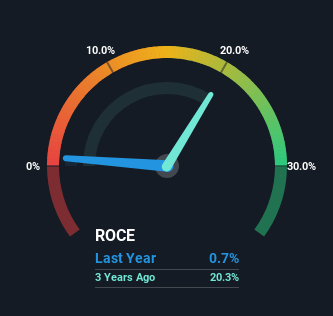- China
- /
- Metals and Mining
- /
- SZSE:002075
Be Wary Of Jiangsu Shagang (SZSE:002075) And Its Returns On Capital

What are the early trends we should look for to identify a stock that could multiply in value over the long term? Ideally, a business will show two trends; firstly a growing return on capital employed (ROCE) and secondly, an increasing amount of capital employed. Basically this means that a company has profitable initiatives that it can continue to reinvest in, which is a trait of a compounding machine. Having said that, from a first glance at Jiangsu Shagang (SZSE:002075) we aren't jumping out of our chairs at how returns are trending, but let's have a deeper look.
Understanding Return On Capital Employed (ROCE)
Just to clarify if you're unsure, ROCE is a metric for evaluating how much pre-tax income (in percentage terms) a company earns on the capital invested in its business. Analysts use this formula to calculate it for Jiangsu Shagang:
Return on Capital Employed = Earnings Before Interest and Tax (EBIT) ÷ (Total Assets - Current Liabilities)
0.0073 = CN¥76m ÷ (CN¥22b - CN¥11b) (Based on the trailing twelve months to March 2024).
So, Jiangsu Shagang has an ROCE of 0.7%. In absolute terms, that's a low return and it also under-performs the Metals and Mining industry average of 6.7%.
View our latest analysis for Jiangsu Shagang

Historical performance is a great place to start when researching a stock so above you can see the gauge for Jiangsu Shagang's ROCE against it's prior returns. If you want to delve into the historical earnings , check out these free graphs detailing revenue and cash flow performance of Jiangsu Shagang.
What The Trend Of ROCE Can Tell Us
In terms of Jiangsu Shagang's historical ROCE movements, the trend isn't fantastic. Around five years ago the returns on capital were 32%, but since then they've fallen to 0.7%. And considering revenue has dropped while employing more capital, we'd be cautious. This could mean that the business is losing its competitive advantage or market share, because while more money is being put into ventures, it's actually producing a lower return - "less bang for their buck" per se.
On a side note, Jiangsu Shagang's current liabilities have increased over the last five years to 52% of total assets, effectively distorting the ROCE to some degree. Without this increase, it's likely that ROCE would be even lower than 0.7%. What this means is that in reality, a rather large portion of the business is being funded by the likes of the company's suppliers or short-term creditors, which can bring some risks of its own.
The Key Takeaway
In summary, we're somewhat concerned by Jiangsu Shagang's diminishing returns on increasing amounts of capital. It should come as no surprise then that the stock has fallen 35% over the last five years, so it looks like investors are recognizing these changes. That being the case, unless the underlying trends revert to a more positive trajectory, we'd consider looking elsewhere.
One final note, you should learn about the 4 warning signs we've spotted with Jiangsu Shagang (including 2 which are potentially serious) .
If you want to search for solid companies with great earnings, check out this free list of companies with good balance sheets and impressive returns on equity.
New: Manage All Your Stock Portfolios in One Place
We've created the ultimate portfolio companion for stock investors, and it's free.
• Connect an unlimited number of Portfolios and see your total in one currency
• Be alerted to new Warning Signs or Risks via email or mobile
• Track the Fair Value of your stocks
Have feedback on this article? Concerned about the content? Get in touch with us directly. Alternatively, email editorial-team (at) simplywallst.com.
This article by Simply Wall St is general in nature. We provide commentary based on historical data and analyst forecasts only using an unbiased methodology and our articles are not intended to be financial advice. It does not constitute a recommendation to buy or sell any stock, and does not take account of your objectives, or your financial situation. We aim to bring you long-term focused analysis driven by fundamental data. Note that our analysis may not factor in the latest price-sensitive company announcements or qualitative material. Simply Wall St has no position in any stocks mentioned.
Have feedback on this article? Concerned about the content? Get in touch with us directly. Alternatively, email editorial-team@simplywallst.com
About SZSE:002075
Jiangsu Shagang
Engages in the development, smelting, processing, and sales of ferrous metal products in China and internationally.
Mediocre balance sheet second-rate dividend payer.
Similar Companies
Market Insights
Community Narratives



